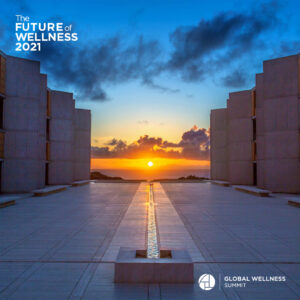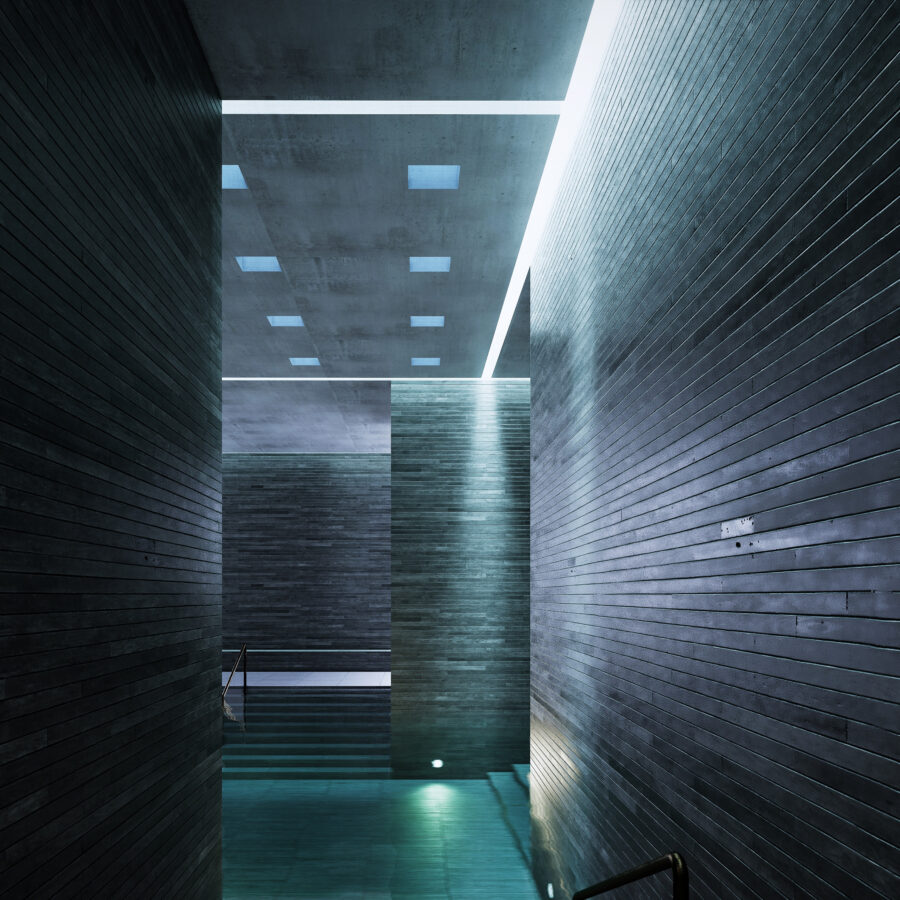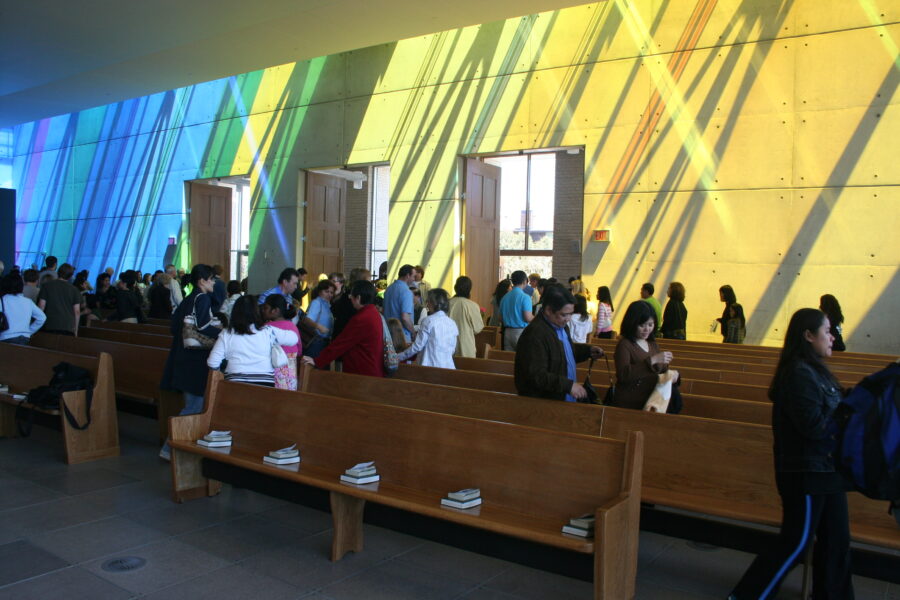
Trend #3
Spiritual and Numinous Moments in Architecture
The move from ostentatious fads to architecture that touches our souls
By Veronica Schreibeis Smith
Introduction
Architecture is a powerful influence on our wellbeing, as it simultaneously impacts all of our senses and each of the Dimensions of Wellness while making up 90% of our surroundings over the course of our lifetime. In recent years, cross-disciplinary studies have proliferated the industry with the science behind how the built environment impacts our wellbeing: hormone production, inflammation, gut and respiratory health, stress level, immunity to diseases and viruses, cognitive performance, social interactions and relationships, emotional wellbeing, and so on. And now, after last year’s great reset imbued awareness of our frenetic pace and extraordinarily consumptive habits, we are seeing architecture elevate its game in all areas, especially the previously glossed over aspect of nurturing our spiritual wellbeing.
The power of this trend is its departure from a look-at-me, visually ostentatious fad or architectural style to a must-be-experienced effect that is subtle, yet potent, in its ability to touch our soul and contribute to transcendental experiences.
As the values of humankind shift,1 a new way to practice spirituality emerges, and architecture’s role becomes evident not only in faith-based architecture but everyday architecture. We are not separate from our buildings; our buildings influence us, nudge our behavior and practices, impact our mood, and inhibit or enhance our capacity to tap into our own spirituality.
“It is timely that we deal with the Spiritual dimension in order to design our way into a sustainable…no, viable…future human presence on the planet,” says Canadian architect Roberto Chiotti.
Architecture’s response has accelerated over the past two decades, from post-war modernism through the green movement of the late 1990s to the current health movement beckoning Wellness Architecture, a holistic design approach rooted in authenticity, lasting quality, and life-enhancing rituals, built in regenerative harmony with Mother Nature.
Of course, an inherent part of achieving Wellness Architecture is the integration of numinous moments—defined as a transcendental experience where one is in contact with the vital, the fascinating, and the mysterious2—in our everyday environments. Most of us have experienced a numinous moment where our thoughts were paused, and awe engulfed us. For a brief time, feelings of bliss, beauty, tranquility, love or gratitude consumed us. Today’s “always on” culture needs such moments to be embedded into secular and sacred architecture alike in order to reset outmoded, deleterious habits (addiction to devices, consumerism, etc.) with meditation, mindfulness, breath work, gratitude and other key wellness practices.
Fueling the Trend
As we collectively move up Maslow’s Pyramid, McMansions are dying as those moving into self-actualization look for architecture to deliver more.
The sophistication of an era’s architecture corresponds to where the population is on Maslow’s Pyramid. A cave was great shelter when every day was a struggle to sustain life. Conversely, much of the real estate product released onto the market in recent decades maximizes square footage and bedroom count but removes quality to achieve the most inexpensive cost per square foot possible while still including as many luxury features as possible. This has been a response to the Esteem tier of Maslow’s Pyramid. Now, we are looking for architecture to respond to the Self-Actualization tier.
“We are at the apex of ego, consumption and excess. This is a departure from our natural selves,” explains Dr. Jonathan Salk. At every apex, there is a transition. Each of us is ultimately responsible for creating our own sacred life. Our actions, what we eat, and what we choose to surround ourselves with matters. We create everyday magic for ourselves and our loved ones.
Dr. Phillip Tabb, architect and professor emeritus of Texas A&M University, points out that the average homeowner uses someone else’s ideas of what a house “should” be like, rather than going through their own introspective and self-reflective process. But this is changing. The idea that form follows function is expanding beyond the utilitarian tasks associated with daily life, like parking the car inside (garage) or washing the dishes (ergonomic dimensions and articulating spray head on a faucet). Art and beauty are not frivolous but rather serve the function of elevating our mood and inciting wonder, necessary emotions and intellectual occurrences for wellbeing. The same is true for integrating numinous moments in architecture and urban design for spiritual wellbeing.
Throughout time, humans have focused—and lost focus—on sacredness in architecture, and now we see a resurgence.
 Spirituality is shifting from the ubiquitous church-going on Sundays to something both the devout and atheist aspire to integrate daily in their pursuit of self-actualization. Universal traits of spirituality include things like connecting to the divine, knowing your purpose, achieving your highest potential, using your talents for the betterment of others, and living in the present moment. Our desire to more deeply integrate mind, body and soul is rapidly increasing, as is evident with the explosion of meditation and mindfulness tools in the marketplace, as well as watching wellness sectors of the economy out-pace other sectors.3
Spirituality is shifting from the ubiquitous church-going on Sundays to something both the devout and atheist aspire to integrate daily in their pursuit of self-actualization. Universal traits of spirituality include things like connecting to the divine, knowing your purpose, achieving your highest potential, using your talents for the betterment of others, and living in the present moment. Our desire to more deeply integrate mind, body and soul is rapidly increasing, as is evident with the explosion of meditation and mindfulness tools in the marketplace, as well as watching wellness sectors of the economy out-pace other sectors.3
Spiritual wellbeing is an inextricable part of a well life, and rightfully deserves design consideration and designated spaces in our homes, workplaces and urban landscapes.
Aspects of the Trend Designers can use environmental cues to have both conscious and subconscious effects.
Nudge architecture is the concept of designing cues into the environment that influence behavior while still allowing an individual to make their own choice. For example, to promote movement, one might place a beautiful stairway in the entry and tuck the elevator core in the back corridor. In the same way, cues can be designed into the environment, such as meditation coves or earthing and grounding zones in workplace courtyards, to remind and enable individuals to enjoy their spiritual practices as a part of daily life.
While nudge architecture may be conscious or subconscious, some ancient traditions such as Vastu architecture and feng shui work in another realm. These practices use techniques like orientation, proportions, astrology, placement of rooms and furnishings, and blessing ceremonies to influence the energy connected to life events, health and relationships.
“It is my experience that living in a Maharishi Vastu home, I have felt deep, deep contentment, deepening of my meditation, and more harmony with my partner. They are profound enough that I have come to think of living in the house as a spiritual practice,” says Vastu architect Jon Lipman, AIA. This seems to be a widespread experience, in that a peer-reviewed, published world survey of others living in Maharishi Vastu homes found that 86% of them have associated their time in the home with spiritual growth, and about 80% find living in the home is associated with finding greater meaning in life.4
Similarly, “Classical feng shui is based upon ancient principles of creating harmony with the three realms of heaven, humanity and nature.
As such, a feng shui-designed building resonates a unique vibration that helps the occupant feel calmer and more spiritually aligned and at peace with the world, especially if their unique ancient Chinese astrology is also incorporated in the design in terms of the compass directions that support the individuals,” explains Sarah McAllister, director of the Feng Shui Agency in London. “It is so tangible that [clients] often tell me that even friends who visit remark on how good they feel, and that they don’t want to leave!”
Thin places provide the setting to more easily tap into the divine and our deeper selves.
In his book Elemental Architecture: Temperaments of Sustainability, Dr. Phil Tabb describes how we can lift or “thin” the veil between the secular realm—ordinary, everyday spaces where time is dense, and space is fractious—and the sacred realm, where space is charged, and one is present, accompanied with enhanced perception, nearness and numinous qualities.
The secular realm is characterized by things like materialism, too much time spent indoors (over 90%), focus on survival (demanding job), and obsession with entertainment and devices. On the other hand, thin places are designed as a setting to experience the sacred realm. Dr. Tabb illustrates 16 patterns that characterize thin places, such as transitioning into the space with a threshold, groundedness and celestial presence, light and luminosity, and beneficial manifestations of nature.
Neuro-phenomenological studies show spiritual moments in architecture impact our consciousness.
When entering a thin place, the depth of the experience then relies on the individual. However, an uplifting effect is universal. Dr. Julio Bermudez, president of the Architecture, Spirituality, and Culture Forum and professor at CUA School of Architecture and Planning, studies the neuroscience behind our architectural experiences, focusing on contemplative states. He found, in certain non-ordinary buildings, our frontal lobe shuts down, like in meditation, and the executive functions of our brain (critical, judgmental) are less activated.5 “We enter into a non-dualistic state, our highest state,” Dr. Bermudez says. Spaces can be customized for certain experiences and certain individuals to enter one’s flow state to achieve their highest performance time and time again.
AI and virtual and augmented reality are no match for the real thing.
Many tools that architects use as a basis for creating sacred spaces are rooted in the math of nature. Sacred geometry uses relationships like the Fibonacci sequence and the Vitruvian man to determine the dimensions of a space in order to create a resonance between the two. Biogeometry, the measurement of the life force of the Earth, consists of working with the body’s subtle energy and creates a built environment that harmonizes energy, such as electromagnetic fields and the Earth’s meridians.6
So, if the tool is mathematical, can all designers be taught this, or better yet, could software be programmed to assist in the design process? The answer is no. Neither checklists nor AI algorithms of sacred geometry can replace the role of a gifted architect because the secret sauce is not formulaic. Think of it as a musician. Many of us can learn musical theory and even learn to play an advanced piece of music, but it takes a master with innate abilities to compose the nuances and movements that transport us into another realm.
This brings up the aspect of whether or not virtual and augmented reality could fill the void of creating sacred spaces. There is evidence that our experience when using technology is similar to an actual experience, just as a dream can feel very much real. However, this is not a long term fix. “Earth is our sacred reality,” says Chiotti. Goggles and headphones can only take you so far. We cannot live a well life in an unwell environment.

The Future
It is time for our buildings to deliver wellbeing beyond code requirements.
A silver lining of 2020 was that we can no longer turn a blind eye to subpar building environments. Just as we won’t be able to go back to minimal amounts of poorly filtered air, we will no longer accept secular environments that disregard a need to uplift us emotionally, maximize our cognitive performance, bring us to the present moment, and allow us space to breathe and be mindful. Standards considered “high performance” last century are now out-of-date, as they too often diminished our physical health while being completely devoid of design solutions for social, intellectual, emotional and spiritual optimization.
Policy lags behind expectations, but the good news—and caution to practicing architects—is that architects are responsible for delivering the local standard of care, even if it exceeds code requirements. The Wellness Architecture standard for “high performance” buildings will find regenerative solutions to enhance our physical, mental and emotional wellbeing while building in moments that nourish our souls with transcendental experiences.
Living in balance means integrating spiritual moments into daily life at home, work and the community.
Near term developments will include rethinking layouts in the everyday places that we take for granted. Consider the past approach of grouping fixtures for personal hygiene—vanity, toilet and shower—in one room. The future will be designing for elevated rituals rather than basic hygiene, so the “bath room” will be designed as a sacred space for bathing rituals and detox baths that relax and rejuvenate the mind and body while setting the stage for introspection and connection with our higher self; a space no longer appropriate for a toilet.
 Our homes will transform with refinements that add a spiritual dimension: Wellness kitchens7 will be designed in a way that preparing whole foods becomes a joyful and relaxing ritual, while bringing ease to personalized nutrition, thereby optimizing health; bedrooms will become sleep sanctuaries more thoughtfully arranged to reflect the sacredness of winding down in preparation for dreamtime and awakening to greet a new day and new opportunity to meet your fullest potential; personal symbols, artifacts, mythology, astrology, cultural heritage and other sacred and sentimental elements will be customized, adding character and soul to the home; meditation and exercise coves may take minimal square footage while providing a space for these essential daily practices.
Our homes will transform with refinements that add a spiritual dimension: Wellness kitchens7 will be designed in a way that preparing whole foods becomes a joyful and relaxing ritual, while bringing ease to personalized nutrition, thereby optimizing health; bedrooms will become sleep sanctuaries more thoughtfully arranged to reflect the sacredness of winding down in preparation for dreamtime and awakening to greet a new day and new opportunity to meet your fullest potential; personal symbols, artifacts, mythology, astrology, cultural heritage and other sacred and sentimental elements will be customized, adding character and soul to the home; meditation and exercise coves may take minimal square footage while providing a space for these essential daily practices.
Workplaces will follow the example of the Salk Institute, where Jonas Salk and Louis Kahn intentionally set out to create spiritual experiences8 as a way to cultivate relationships and elevate the science that would happen within the place. The institute is arguably the most universally profound numinous moment in contemporary secular architecture, where, from the moment of arrival, one is overtaken with introspection as a humble water trough reaches out to the expansive ocean horizon, and the monumental walls inspire a sense of meaning to the work about to take place, while the interior spaces are designed to facilitate a clear mind and flow of intuition, allowing one’s best work.
Real estate developments will transform from the monotonous greige cookie-cutter subdivisions to wellness communities with a strong sense of place and identity, honoring the natural environment and nurturing the close-knit members who reside there. Serenbe, located outside Atlanta, is a model wellness community developed by Stephen Nygren, who engaged Dr. Phillip Tabb to do the urban design. Tabb employed biophilia, place-making strategies, and elegant combinations of sacred geometry nestled into the natural terrain. Intentional numinous and noetic moments are built both in the urbanscape and deep within the local woods, such as the “Be Still” meditation bench that stops you in your tracks and brings you to the present moment as light filters through the deciduous forest, smells of leaves waft up from the forest floor, and a babbling brook quietly serenades you.
The temple has a bright future, and its form will multiply.
Sacred spaces will become protected, and not just as tourist destinations. Rather, measures will be taken to protect and enhance the experience of the place. We will see a revival in the temple, which will manifest in both faith-based and everyday architecture. These transcendental places will come in various forms and unexpected places as an inherent and integrated part of our daily routines and wellness practices.
Endnotes
1 Salk, Jonas and Salk, Jonathan. A New Reality: Human Evolution for a Sustainable Future. City Point Press, Stratford, CT. 2018
2 Phillip James Tabb, Elemental Architecture: The Temperaments of Sustainability, (London, UK: Routledge, 2019).
3 Global Wellness Economy Diagram, Global Wellness Summit, https://globalwellnessinstitute.org/press-room/statistics-and-facts/.
4 L. Fergusson, S. Nidich, A. Bonshek, and R. Nidich, “Maharishi Vedic Architecture and quality of life: An international mixed methods study of lived experience,” International Journal of Architecture and Urban Development 10, no. 4, (Autumn 2020): 1-18.
5 J. Bermudez et al., “Externally-induced meditative states: an exploratory fMRI study of architects’ responses to contemplative Architecture,” Frontiers of Architectural Research 6 no. 2, (2017):123–136.
6 Dr. Ibrahim Karim, BioGeometry Signatures: Harmonizing the Body’s Subtle Energy Exchange with the Environment.
7 Vera Iconica Wellness Kitchen, https://www.veraiconicakitchen.com/.
8 ANFA talk by Design Intelligence, https://www.di.net/articles/reflections-on-the-relationship-between-lou-kahn-and-jonas-salk/.
Download this 2021 trend and receive the 2021 mid-year update as well. The 2022 Future of Wellness global trends report is now available. View the latest trends. Subscribe to our mailing list and receive the bi-weekly TRENDium, a compendium of the trends impacting the multi-trillion dollar global wellness economy featuring the latest news and insights. Sign-up to receive the TRENDium.
